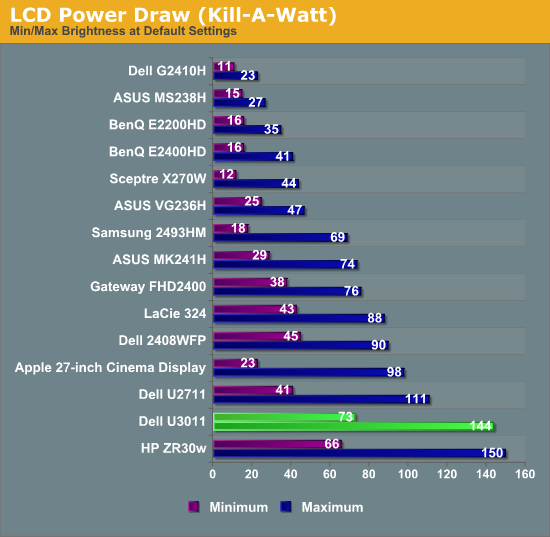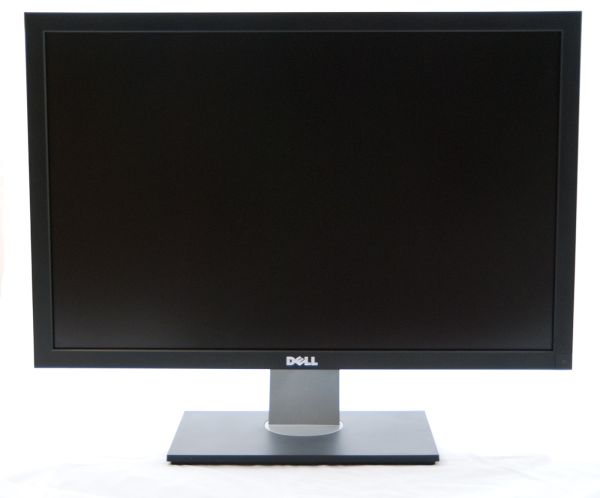Dell U3011 Review: Dell's New 30-inch Flagship
by Brian Klug on January 13, 2011 9:17 PM ESTPower Consumption
The 30-inch category of displays have always been power hungry, and the U3011 is no exception. Laws of physics still apply here, and when it comes down to it, there's just a lot of area to fill with photons. The U3011 specifications note that power use of 250 watts is maximum, 110 is typical, and standby is around 1 watt.

At maximum brightness, the U3011 draws 144 watts. At minimum, 73. That's just slightly below the ZR30w, but not really enough to make it notably better or worse.
We don't measure it directly, but subjectively the U3011 feels surprisingly cool. There isn't a ton of heat which seems to come out the top grilles, nor a ton of heat coming out the front (unlike my BenQ FP241w monitor array which seems to noticeably warm my face).
Conclusions and Final Thoughts
The U3011 is an all around good performer, though I find myself wishing that contrast and Delta-E were just a bit better so it was an unequivocal winner in all the right areas. That said, it does have a number of advantages over the HP ZR30w, namely an OSD, a wealth of input options, and audio pass through. Where the HP ZR30w bests the U3011 is with its excellent display arm which feels subjectively sturdier and beefier, and its slightly better color performance and input latency. Heck, maybe there's something to be said for not having that display controller SoC.
If accessory inputs like an extra DVI and HDMI port are what matters (not to mention the option of having 5.1 audio out), the U3011 is the better choice. As an all around desktop display, the ZR30w edges out in my mind purely because of the slightly better display performance and build quality - it feels solid and just seems to have a much beefier display arm. It's a tossup that ultimately comes down to what features are really most important, and price. Right now, even price is a tossup, as the two are priced within $10 of each other on Amazon. Personally, having HDMI with audio pass through and all the scaling options makes the U3011 the better pick, but again that's just my take. Now the question is: who will be first to market with a 120 Hz 30-incher?











123 Comments
View All Comments
dimensional - Wednesday, June 1, 2011 - link
This U3011 is large enough to be appropriate for a wall mount. Yet, it seems nobody is asking about the problem with the screws for the mount being way too small and short. Because of the problem, I will need to replace those screws with longer ones just to be able to at least secure the screws most of the way through the holes after installing a thin wall mount onto it. It makes no sense for them to not give you any longer screws so you can mount the huge monitor. Specially after spending a small fortune for the monitor in the first place.ab_ba - Tuesday, February 7, 2012 - link
The review mentions some speckling on this screen. I have an NEC PA271 but the speckling is too annoying. Can anybody comment if it will be better on this screen, or on the HP ZR30?bjnicholls - Monday, November 26, 2012 - link
After reading the reviews for the NEC, HP, and Dell 30" monitors, I decided to give the Dell a try. I currently have an older NEC 3090wqxi that's developing some blotchy gray areas along the upper left edge of the display, and I need a replacement (perhaps letting me get the old NEC repaired if the gray is perhaps a cleanable dust layer).I found a price under $1K from Amazon and decided to give the U3011 a shot. It arrived today and as soon as I tuned it on I was disappointed. On my unit, there was an immediately obvious green shift on the left third of the screen, and that color inconsistency didn't improve at all after the display was warmed up. Nor is it affected by switching between the built-in profiles. Looking at a white screen, the Dell's luminosity is also very inconsistent; my old NEC is still dramatically better. I'm just here to weigh in as a professional graphic designer and photographer. If you care about color accuracy don't bother with the Dell U3011. There's a reason it's half the price of the current NEC PA301w. I suspect that a photographer or designer would be better off spending the price of the U3011 on the smaller 27" NEC PA201w.
Maybe I just got a bad sample, but I very much doubt that the average U3011 is much better and I'm not going to try exchanging it. Despite user reviews and relatively positive articles like this one, I don't believe the Dell U3011 is viable for professional level work. Dell's inclusion of a "calibration" report is really worthless, since it's obviously a spot calibration and doesn't demonstrate any level of consistency for color across the display.